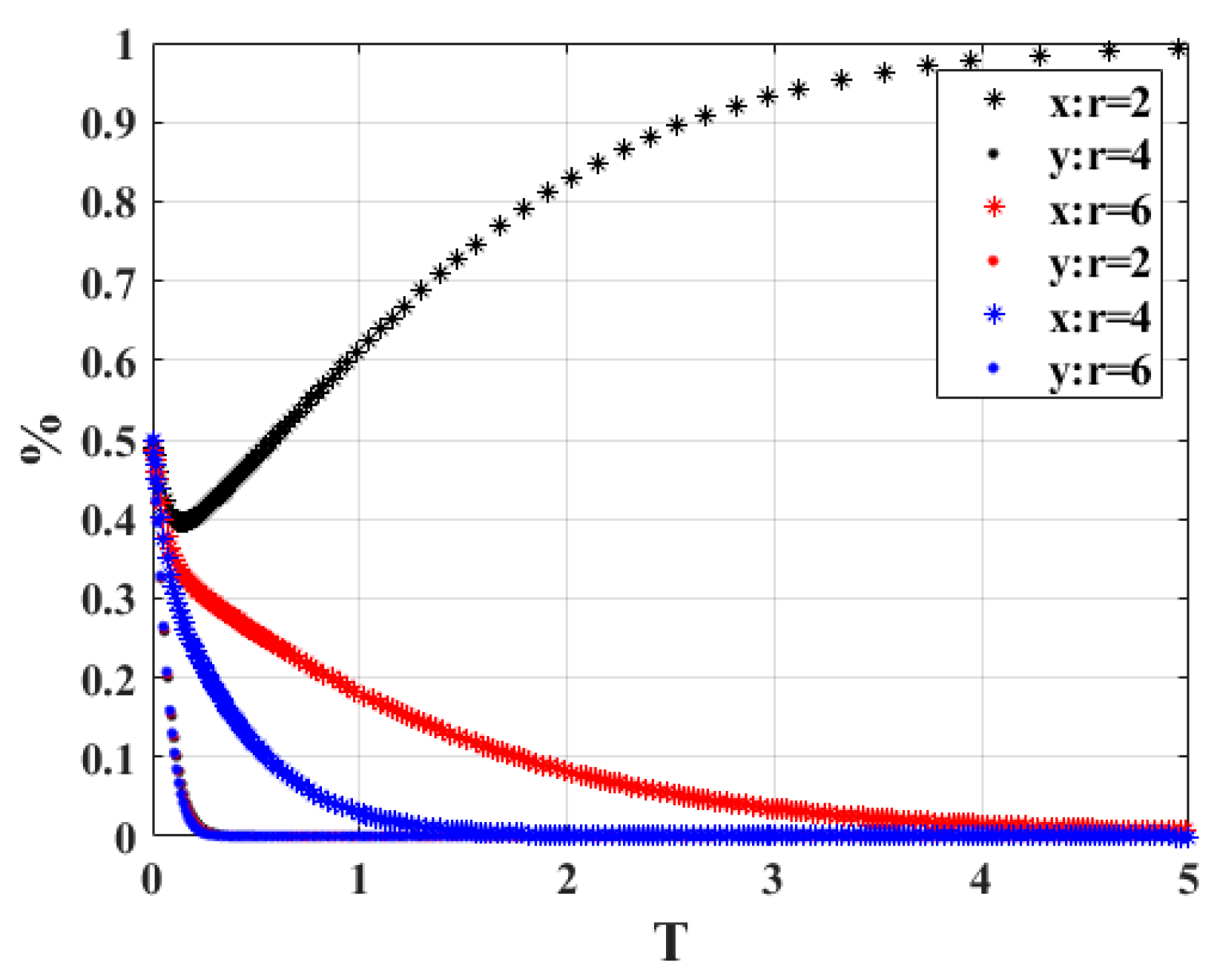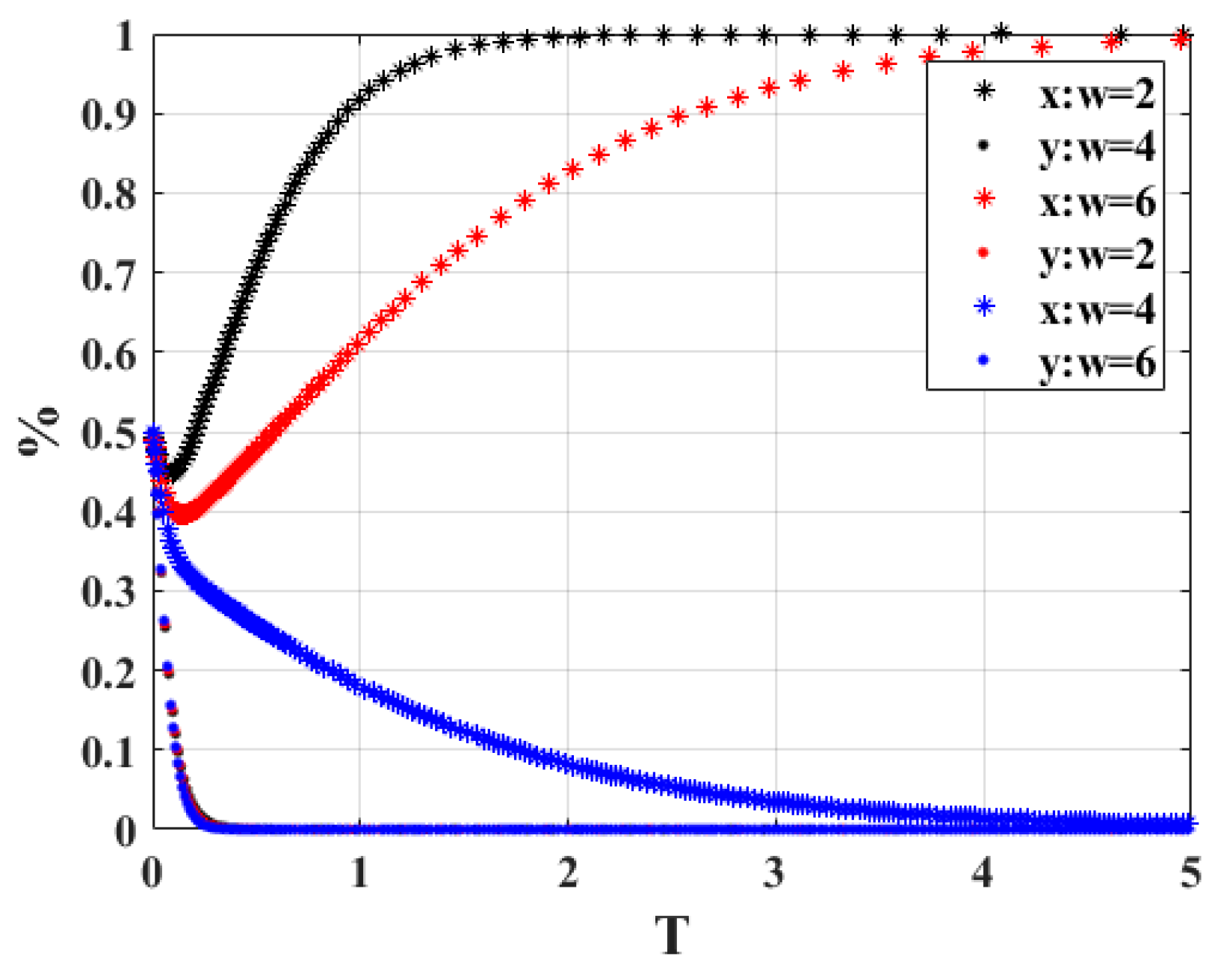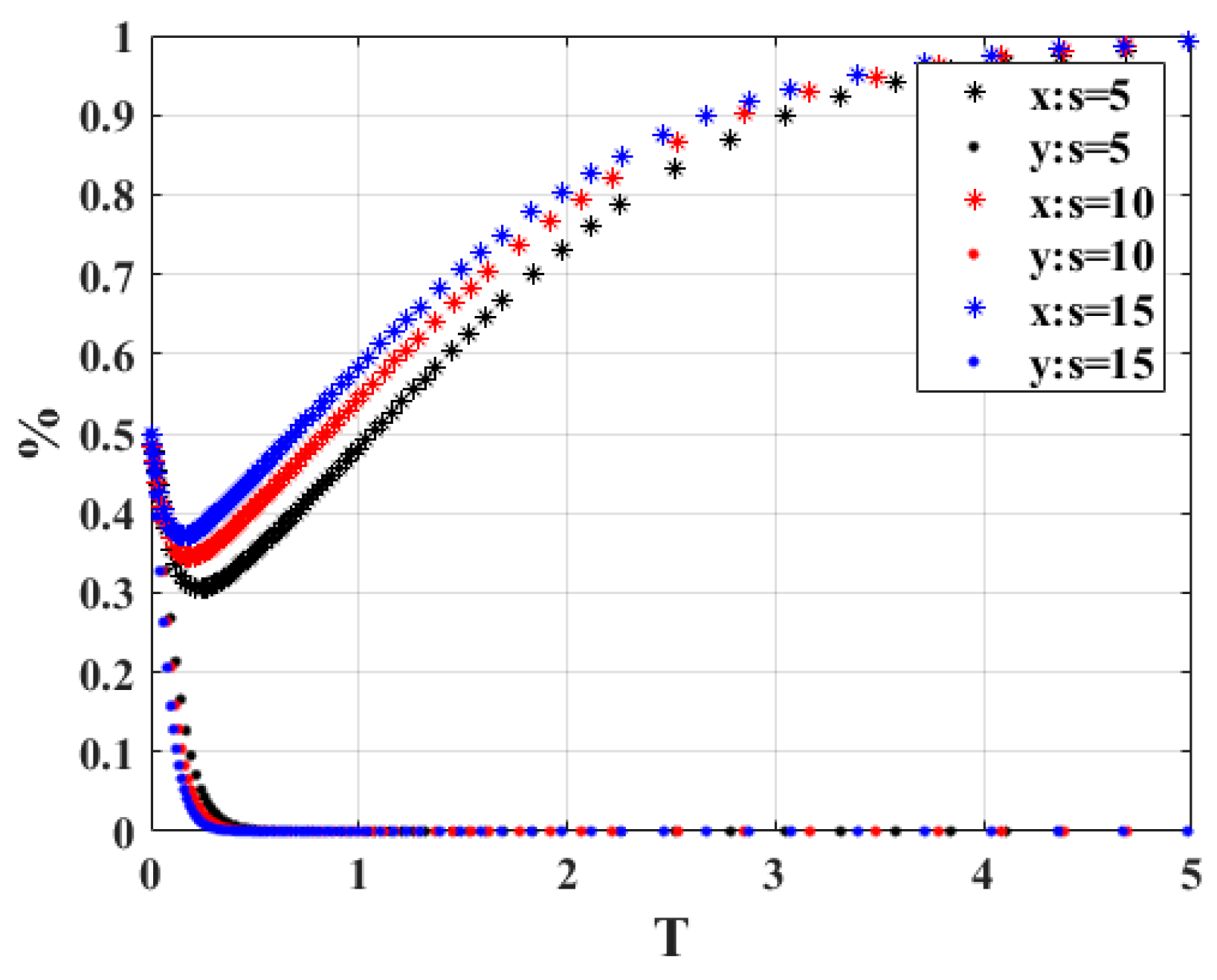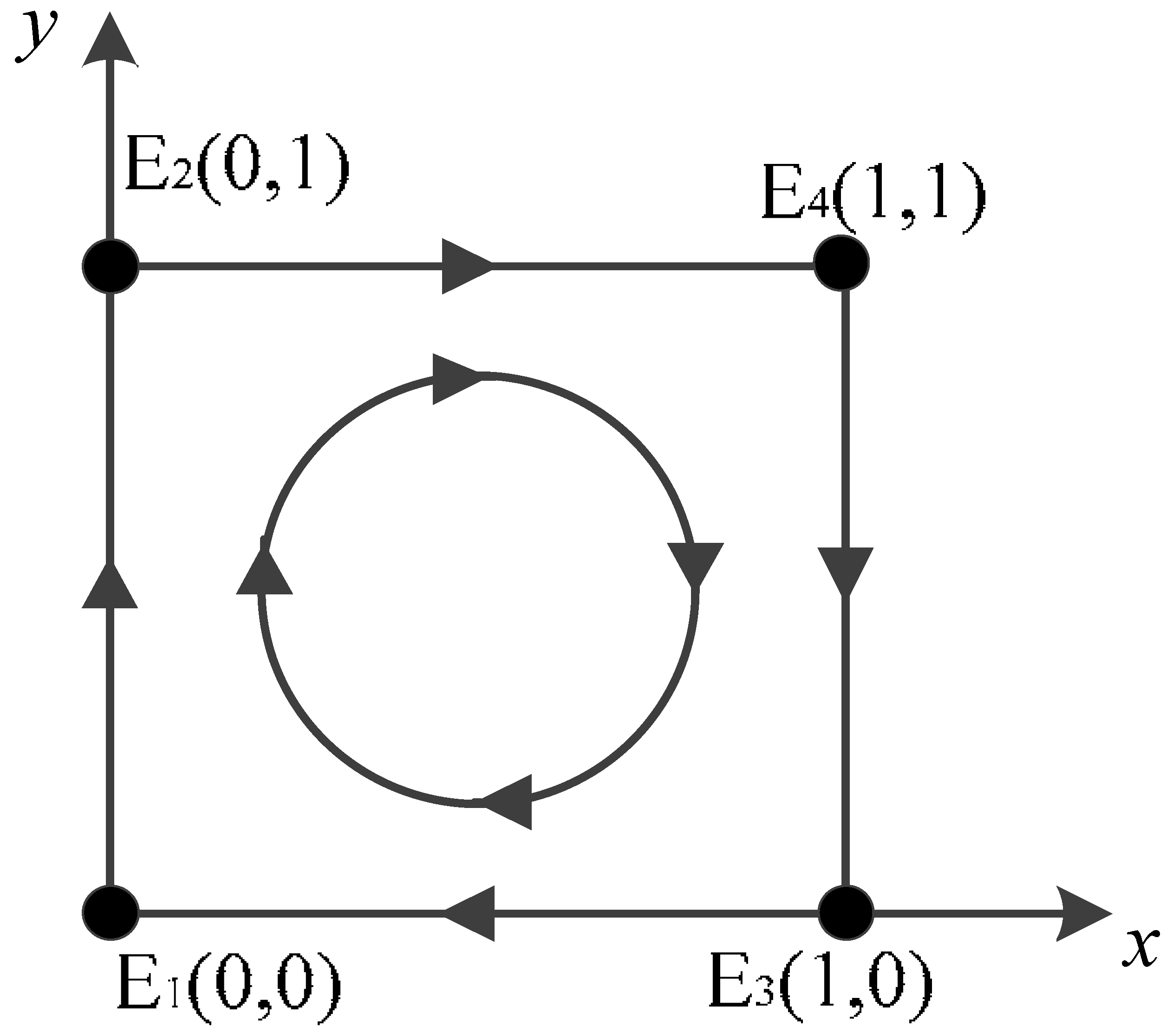Research on the Carbon Credit Exchange Strategy for Scrap Vehicles Based on Evolutionary Game Theory
Abstract
:1. Introduction
2. Literature Review
3. Modeling
3.1. Model Assumptions
3.2. Parameter Assumptions and Model Construction
4. Analysis
4.1. Owner Stability Analysis
4.2. Government Stability Analysis
4.3. Mixing Stability Analysis
5. Results and Discussion
5.1. Simulation Analysis of Stability Results in Different Scenarios
5.2. Both Participating Subjects Initial Willingness Sensitivity Analysis
5.3. Sensitivity Analysis of the Main Parameters of the System
- 1.
- When the government verifies that the penalty for the owner’s behavior of not actively scrapping the vehicle “t” is 5, 10, and 15, respectively, the strategy choices of both sides of the system game are shown in Figure 3. When t = 5 and t = 10, the government and vehicle owners will eventually choose the strategy combination of non-participation strategy and active scrapping, but when t increases to 15, as time passes, the game will eventually choose the strategy combination of participation strategy and active scrapping. In terms of the equilibrium time point, it can be seen that the time required for the owner to reach the steady state is much less than that required by the government, and as the value of t increases, more time is required for the government to reach the equilibrium state. The results indicate that when the penalty for car owners increases, the government prefers the proactive engagement strategy for active regulation, and it can achieve more profit from fines. At the same time, owners actively cooperate with the strategy to complete the scrapping of scrap vehicles, which will reduce carbon emissions.
- 2.
- When the probability of vehicle owners not actively scrapping their vehicles is verified by the government, “v” is 0.3, 0.6 and 0.9, respectively, the strategy choices of both sides of the system game are shown in Figure 4. When v = 0.3 and t = 0.6, the strategy combination of government and vehicle owners will be non-participation strategy and active scrapping, but when v increases to 0.9, the strategy combination of participation strategy and active scrapping will be chosen by both sides of the game as time passes. Additionally, it is not difficult to find that the government supervisor takes more time to reach the equilibrium state in the system. The results show that when the probability of the vehicle owner’s behavior of not actively scrapping the vehicle is verified by the government increases, the government department tends to participate in the strategy while actively verifying the vehicle owner who does not cooperate with the strategy, so that the vehicle owner actively cooperates with the government department and actively scraps the vehicle, resulting in the evolutionary system tending to equilibrium.
- 3.
- When the owner cooperates with the strategic behavior and the corresponding rewards “u” are 10, 15, and 20, respectively, the strategy choices of both sides of the system game are shown in Figure 5. It is easy to find that regardless of the value of u, both sides of the game will eventually choose the strategy combination of non-participation strategy and active scrapping. However, as the reward increases, the time required to reach a stable strategy for governmental behavior is also reduced. This indicates that the size of the incentive has an impact on the time to reach the stable state of the system, and the owners can be made to actively scrap their vehicles by improving other conditions in different time periods. Therefore, adjusting the appropriate size of the reward is also necessary for the stability of the gaming system.
- 4.
- When the cost “r” of the government’s participation in the carbon integral exchange strategy of scrap vehicles is 2, 4, and 6, respectively, the strategy choices of both parties in the system game are shown in Figure 6. According to the figure, when r = 2, the stability of the strategy combination of the two sides of the game is finally maintained at participation strategy and active scrapping, and as the value of r increases, i.e., when r = 4 and r = 6, the two sides of the game will finally choose the strategy combination of non-participation strategy and active scrapping, and as the cost of government participation in the strategy is higher, the time required to evolve to the stable point state is shorter. It is easy to understand that if the cost of the government involvement strategy is low, on the one hand, it can deter vehicle owners from actively scrapping their vehicles, and on the other hand, it can save financial expenditure, and the government is willing to actively participate in the strategy because the overall benefit of the system is positive. As the cost of participation increases, when the benefit obtained is lower than the high cost of participation, the government departments tend toward the non-participation strategy, and the game time is shortened as the cost increases.
- 5.
- The cost required for the government department to verify the strategy when “w” is 2, 4, and 6, respectively, and the strategy choices of both sides of the game are shown in Figure 7. According to the analysis results, when w = 2 and w = 4, the strategy combination of both sides of the game finally remains at participation strategy and active scrapping, and when w = 6, the government department and the car owner will choose the non-participation strategy and active scrapping game combination. As can be seen in the figure, when w is taken as either too small or too large, it will shorten the time for the system to reach the equilibrium stability point. The value of w value has little effect on the owners to reach the stability state; both tend toward active scrapping. The cost of the verification strategy is also correlated with the penalty obtained, and the government will be reluctant to participate in the strategy if the cost of verification is too high and the benefits of the penalties obtained are too low to cover the costs. Therefore, the cost of the appropriate verification strategy will directly affect how the gaming system is chosen.
- 6.
- The strategy choice of both sides of the system game is shown in Figure 8, when the cost of the owner’s scrap vehicle “s” is 5, 10 and 15, respectively. According to the analysis results, it can be seen that regardless of the value of s, the strategy combination between the government and the vehicle owner game will eventually stabilize at participation strategy and active scrapping. In terms of the time required to reach stability, the time for both sides of the game to reach stability decreases as the cost of scrapping vehicles increases. The cost of scrapping a vehicle does not affect the outcome of the game, but the necessary macroeconomic regulation to ensure a stable market equilibrium is also necessary.
- 7.
- The strategy choice of both sides of the system game is shown in Figure 9 when the owner does not cooperate with the strategy and scraps the vehicle negatively while receiving the benefits “p” of 5, 10, and 15, respectively. According to the analysis results, it can be seen that regardless of the value of p, the strategy combination of the two sides of the game will eventually stabilize at non-participation strategy and active scrapping. However, as the value of p increases, the time for the government to reach stability will be extended, showing a positive correlation and the time for the owners to reach stability will be shortened, showing a negative correlation. This indicates that the strategy finally chosen by the government department will not change because of the benefits received by the owners for negatively scrapping their vehicles but can regulate the time for the system to reach stability by the benefits received. Due to the imperfection of relevant laws and regulations, the advantages and disadvantages of negative vehicle scrapping cannot be clearly identified yet, so the next step is for government departments to continue to improve relevant laws and regulations, improve the operability of the interests of both parties in the game system, improve the reward and punishment system and carbon credit exchange strategy, force vehicle owners to scrap their vehicles actively, and carry out the carbon credit exchange strategy for scrap vehicles.
6. Conclusions
Author Contributions
Funding
Institutional Review Board Statement
Informed Consent Statement
Data Availability Statement
Conflicts of Interest
References
- Yu, L.; Chen, M.; Yang, B. Recycling Policy and Statistical Model of End-of-Life Vehicles in China. Waste Manag. Res. 2019, 37, 347–356. [Google Scholar] [CrossRef]
- Lu, J.; Li, B.; Li, H.; Al-Barakani, A. Expansion of City Scale, Traffic Modes, Traffic Congestion, and Air Pollution. Cities 2021, 108, 102974. [Google Scholar] [CrossRef]
- Wu, Q.; Zhang, G.; Cheng, W. The Key Technologies and Challenges of Mobility as a Service. In Proceedings of the 2022 IEEE 25th International Conference on Intelligent Transportation Systems (ITSC), Macau, China, 8–12 October 2022; pp. 767–772. [Google Scholar]
- Wang, M.; Wang, Y.; Chen, L.; Yang, Y.; Li, X. Carbon Emission of Energy Consumption of the Electric Vehicle Development Scenario. Environ. Sci. Pollut. Res. 2021, 28, 42401–42413. [Google Scholar] [CrossRef]
- Chang, F.; Jie, M.; Liu, W. Management and Innovation of Robot in Automobile Production Line. In Proceedings of China SAE Congress 2018: Selected Papers; China Society of Automotive Engineers (China SAE), Ed.; Lecture Notes in Electrical Engineering; Springer: Singapore, 2020; Volume 574, pp. 153–166. ISBN 9789811397172. [Google Scholar]
- Wu, Q.; Zhang, X.; Cao, G. Study on the Prevention and Control Measures of China’s Urban Road Traffic Noise Pollution. E3S Web Conf. 2019, 96, 03003. [Google Scholar] [CrossRef]
- Wei, Y.-M.; Chen, K.; Kang, J.-N.; Chen, W.; Wang, X.-Y.; Zhang, X. Policy and Management of Carbon Peaking and Carbon Neutrality: A Literature Review. Engineering 2022, 14, 52–63. [Google Scholar] [CrossRef]
- Yang, G.; Jia, L. Estimation of Carbon Emissions from Tourism Transport and Analysis of Its Influencing Factors in Dunhuang. Sustainability 2022, 14, 14323. [Google Scholar] [CrossRef]
- Oldfield, E.E.; Eagle, A.J.; Rubin, R.L.; Rudek, J.; Sanderman, J.; Gordon, D.R. Crediting Agricultural Soil Carbon Sequestration. Science 2022, 375, 1222–1225. [Google Scholar] [CrossRef]
- Zhu, Y.; Koutra, S.; Zhang, J. Zero-Carbon Communities: Research Hotspots, Evolution, and Prospects. Buildings 2022, 12, 674. [Google Scholar] [CrossRef]
- Chen, G.; Dong, K.; Wang, S.; Du, X.; Zhou, R.; Yang, Z. The Dynamic Relationship among Bank Credit, House Prices and Carbon Dioxide Emissions in China. Int. J. Environ. Res. Public Health 2022, 19, 10428. [Google Scholar] [CrossRef]
- Qin, J.; Gao, L.; Tu, W.; He, J.; Tang, J.; Ma, S.; Zhao, X.; Zhu, X.; Brindha, K.; Tao, H. Decomposition and Decoupling Analysis of Carbon Emissions in Xinjiang Energy Base, China. Energies 2022, 15, 5526. [Google Scholar] [CrossRef]
- Rosales-Tristancho, A.; Brey, R.; Carazo, A.F.; Brey, J.J. Analysis of the Barriers to the Adoption of Zero-Emission Vehicles in Spain. Transp. Res. Part A Policy Pract. 2022, 158, 19–43. [Google Scholar] [CrossRef]
- Xu, Y.; Ma, X.; Zhou, G. Coordination of Automobile Supply Chain Considering Relative Endurance Level under the Dual-Credit Policy. Sustainability 2022, 14, 13704. [Google Scholar] [CrossRef]
- Sanjeev, R.; Vrath, R.V.; Sreedhar, P.; Ambala, A.; Jagannadham, V. Carbon Credits: Project Based Learning to Enhance Conceptual Understanding. Reson 2022, 27, 667–671. [Google Scholar] [CrossRef]
- He, H.; Li, S.; Wang, S.; Chen, Z.; Zhang, J.; Zhao, J.; Ma, F. Electrification Decisions of Traditional Automakers under the Dual-Credit Policy Regime. Transp. Res. Part D Transp. Environ. 2021, 98, 102956. [Google Scholar] [CrossRef]
- Chen, K.; Zhao, F.; Hao, H.; Liu, Z.; Liu, X. Hierarchical Optimization Decision-Making Method to Comply with China’s Fuel Consumption and New Energy Vehicle Credit Regulations. Sustainability 2021, 13, 7842. [Google Scholar] [CrossRef]
- Lee, S.; Park, B. Study for Zero Emission Vehicle Technology: Current Status and Recent Trends. J. Converg. Cult. Technol. 2019, 5, 377–384. [Google Scholar] [CrossRef]
- Axsen, J.; Bhardwaj, C.; Crawford, C. Comparing Policy Pathways to Achieve 100% Zero-Emissions Vehicle Sales by 2035. Transp. Res. Part D Transp. Environ. 2022, 112, 103488. [Google Scholar] [CrossRef]
- Qin, J.; Bai, X.; Xia, L. Sustainable Trade Credit and Replenishment Policies under the Cap-And-Trade and Carbon Tax Regulations. Sustainability 2015, 7, 16340–16361. [Google Scholar] [CrossRef]
- Liu, Z.; He, S.; Li, W.; Sun, H. Does Green Credit Reduce Carbon Emissions? Evidence from China. Environ. Sci. Pollut. Res. 2022, 1–17. [Google Scholar] [CrossRef]
- Hu, Y.; Zheng, J. Is Green Credit a Good Tool to Achieve “Double Carbon” Goal? Based on Coupling Coordination Model and PVAR Model. Sustainability 2021, 13, 14074. [Google Scholar] [CrossRef]
- Raju, A.S.K.; Wallerstein, B.R.; Johnson, K.C. Achieving NOx and Greenhouse Gas Emissions Goals in California’s Heavy-Duty Transportation Sector. Transp. Res. Part D Transp. Environ. 2021, 97, 102881. [Google Scholar] [CrossRef]
- Hyde, M.; Boron, V.; Rincón, S.; Viana, D.F.P.; Larcher, L.; Reginato, G.A.; Payán, E. Refining Carbon Credits to Contribute to Large Carnivore Conservation: The Jaguar as a Case Study. Conserv. Lett. 2022, 15, e12880. [Google Scholar] [CrossRef]
- Kong, H.; Shi, L.; Da, D.; Li, Z.; Tang, D.; Xing, W. Simulation of China’s Carbon Emission Based on Influencing Factors. Energies 2022, 15, 3272. [Google Scholar] [CrossRef]
- Yang, L.; Hu, X.; Fang, L. Carbon Emissions Tax Policy of Urban Road Traffic and Its Application in Panjin, China. PLoS ONE 2018, 13, e0196762. [Google Scholar] [CrossRef]
- Gao, R.; Li, X.; Yu, H. Prediction Method of Green Transportation Carbon Emission in Smart City Based on Gray Joint Algorithm. In Proceedings of the 2021 6th International Conference on Smart Grid and Electrical Automation (ICSGEA), Kunming, China, 29–30 May 2021; pp. 30–34. [Google Scholar]
- Wang, J.; Chi, L.; Hu, X.; Zhou, H. Urban Traffic Congestion Pricing Model with the Consideration of Carbon Emissions Cost. Sustainability 2014, 6, 676–691. [Google Scholar] [CrossRef]
- Wang, L.; Fan, J.; Wang, J.; Zhao, Y.; Li, Z.; Guo, R. Spatio-Temporal Characteristics of the Relationship between Carbon Emissions and Economic Growth in China’s Transportation Industry. Environ. Sci. Pollut. Res. 2020, 27, 32962–32979. [Google Scholar] [CrossRef]
- Yaacob, N.F.F.; Mat Yazid, M.R.; Abdul Maulud, K.N.; Ahmad Basri, N.E. A Review of the Measurement Method, Analysis and Implementation Policy of Carbon Dioxide Emission from Transportation. Sustainability 2020, 12, 5873. [Google Scholar] [CrossRef]
- Wang, B.; Sun, Y.; Chen, Q.; Wang, Z. Determinants Analysis of Carbon Dioxide Emissions in Passenger and Freight Transportation Sectors in China. Struct. Change Econ. Dyn. 2018, 47, 127–132. [Google Scholar] [CrossRef]
- Hao, J.; Chen, L.; Zhang, N. A Statistical Review of Considerations on the Implementation Path of China’s “Double Carbon” Goal. Sustainability 2022, 14, 11274. [Google Scholar] [CrossRef]
- Wang, Y.; Zhou, Y.; Zhu, L.; Zhang, F.; Zhang, Y. Influencing Factors and Decoupling Elasticity of China’s Transportation Carbon Emissions. Energies 2018, 11, 1157. [Google Scholar] [CrossRef] [Green Version]
- Sun, Y.; Liu, S.; Li, L. Grey Correlation Analysis of Transportation Carbon Emissions under the Background of Carbon Peak and Carbon Neutrality. Energies 2022, 15, 3064. [Google Scholar] [CrossRef]
- Fan, F.; Lei, Y. Decomposition Analysis of Energy-Related Carbon Emissions from the Transportation Sector in Beijing. Transp. Res. Part D Transp. Environ. 2016, 42, 135–145. [Google Scholar] [CrossRef]
- Zhao, H.; Hu, J.; Hao, F.; Zhang, H. Determinants of Carbon Dioxide Emissions and Their Peaking Prospect: Evidence From China. Front. Environ. Sci. 2022, 10, 913835. [Google Scholar] [CrossRef]
- Feng, Z.; Cheng, S.; Qu, G.; Cui, Y.; Ye, J. Research on Theoretical Mechanism and Promotion Path of Digital Economy Driving China’s Green Development under “Double Carbon” Background. Int. J. Environ. Res. Public Health 2022, 20, 437. [Google Scholar] [CrossRef]
- Chou, J.; Li, Y.; Xu, Y.; Zhao, W.; Li, J.; Hao, Y. Carbon Dioxide Emission Characteristics and Peak Trend Analysis of Countries along the Belt and Road. Environ. Sci. Pollut. Res. 2022, 1–15. [Google Scholar] [CrossRef]
- Li, Y.; Dong, H.; Lu, S. Research on Application of a Hybrid Heuristic Algorithm in Transportation Carbon Emission. Environ. Sci. Pollut. Res. 2021, 28, 48610–48627. [Google Scholar] [CrossRef]
- Kong, Y.; Feng, C.; Guo, L. Peaking Global and G20 Countries’ CO2 Emissions under the Shared Socio-Economic Pathways. Int. J. Environ. Res. Public Health 2022, 19, 11076. [Google Scholar] [CrossRef]
- Pan, G.; Jiang, H.; Jin, Q.; Zhao, T.; Wang, J.; Wang, L. Study on the Sharing Transportation Based on Game Theory. Sustainability 2021, 13, 9347. [Google Scholar] [CrossRef]
- Zhou, K.; Wang, Q.; Tang, J. Evolutionary Game Analysis of Environmental Pollution Control under the Government Regulation. Sci. Rep. 2022, 12, 474. [Google Scholar] [CrossRef]
- Liu, Z.; Qian, Q.; Hu, B.; Shang, W.-L.; Li, L.; Zhao, Y.; Zhao, Z.; Han, C. Government Regulation to Promote Coordinated Emission Reduction among Enterprises in the Green Supply Chain Based on Evolutionary Game Analysis. Resour. Conserv. Recycl. 2022, 182, 106290. [Google Scholar] [CrossRef]
- Xin, F.; Ni, S.; Li, H.; Zhou, X. General Regression Neural Network and Artificial-Bee-Colony Based General Regression Neural Network Approaches to the Number of End-of-Life Vehicles in China. IEEE Access 2018, 6, 19278–19286. [Google Scholar] [CrossRef]
- Yu, Z.; Tianshan, M.; Khan, S.A.R. Investigating the Effect of Government Subsidies on End-of-Life Vehicle Recycling. Waste Manag. Res. 2021, 39, 860–870. [Google Scholar] [CrossRef]
- Liu, M.; Chen, X.; Zhang, M.; Lv, X.; Wang, H.; Chen, Z.; Huang, X.; Zhang, X.; Zhang, S. End-of-Life Passenger Vehicles Recycling Decision System in China Based on Dynamic Material Flow Analysis and Life Cycle Assessment. Waste Manag. 2020, 117, 81–92. [Google Scholar] [CrossRef]
- Grabowski, L.; Gliniak, M.; Polek, D.; Gruca, M. Cost-Assessment Analysis of Local Vehicle Scrapping Facility. IOP Conf. Ser. Earth Environ. Sci. 2017, 95, 022007. [Google Scholar] [CrossRef]
- Al-Quradaghi, S.; Zheng, Q.P.; Betancourt-Torcat, A.; Elkamel, A. Optimization Model for Sustainable End-of-Life Vehicle Processing and Recycling. Sustainability 2022, 14, 3551. [Google Scholar] [CrossRef]
- Yu, Z.; Tianshan, M.; Rehman, S.A.; Sharif, A.; Janjua, L. Evolutionary Game of End-of-Life Vehicle Recycling Groups under Government Regulation. Clean Technol. Environ. Policy 2020, 1–12. [Google Scholar] [CrossRef]
- Zhao, H.; Li, J.; Jiang, X. Static Uncertain Behavioral Game with Application to Investment Problem. Soft Comput. 2020, 24, 2479–2485. [Google Scholar] [CrossRef]
- Jiang, B.; Shu, L. Evolutionary Game Dynamics of Death-Birth Process with Interval Payoffs on Graphs. J. Intell. Fuzzy Syst. 2021, 40, 10087–10098. [Google Scholar] [CrossRef]
- Mainar, E.; Peña, J.M.; Rubio, B. Accurate Computations with Collocation and Wronskian Matrices of Jacobi Polynomials. J. Sci. Comput. 2021, 87, 77. [Google Scholar] [CrossRef]
- Cheng, D.; He, F.; Qi, H.; Xu, T. Modeling, Analysis and Control of Networked Evolutionary Games. IEEE Trans. Autom. Control 2015, 60, 2402–2415. [Google Scholar] [CrossRef]
- Senkerik, R.; Zelinka, I.; Davendra, D.; Oplatkova, Z. Utilization of SOMA and Differential Evolution for Robust Stabilization of Chaotic Logistic Equation. Comput. Math. Appl. 2010, 60, 1026–1037. [Google Scholar] [CrossRef]
- Yang, S.; Yang, D.; Shi, W.; Deng, C.; Chen, C.; Feng, S. Global Evaluation of Carbon Neutrality and Peak Carbon Dioxide Emissions: Current Challenges and Future Outlook. Environ. Sci. Pollut. Res. 2022, 1–20. [Google Scholar] [CrossRef]









| Parameter Assignment | Parameter Meaning | Value Range |
|---|---|---|
| x | Probability that the government will choose an engagement strategy. | 0 ≤ x ≤ 1 |
| y | Probability of the owners choosing to scrap their vehicles. | 0 ≤ y ≤ 1 |
| r | Costs of government participation in scrap vehicles carbon credit exchange strategies. | r > 0 |
| Q | Normal earnings for owners. | Q > 0 |
| s | Costs for the owners to scrap their vehicles. | s > 0 |
| R | Positive economic benefits to the “carbon peaking and carbon neutrality” strategy through the cooperation of vehicle owners with the strategy. | R > 0 |
| p | The owner does not cooperate with the strategy and benefits from the negative scrapping of the vehicle. | p > 0 |
| t | Government verification found that the owner of the vehicle participated in negative scrapping behavior and received a penalty. | t > 0 |
| u | The owner cooperates with the strategic behavior and the corresponding reward is obtained. | u > 0 |
| v | The probability that the negative scrapping behavior of vehicle owners will be verified by the government. | 0 ≤ v ≤ 1 |
| w | Cost of verification strategy for government departments. | w > 0 |
| Gaming Subjects | Government Strategy | ||
|---|---|---|---|
| Participation x | Non-Participation (1 − x) | ||
| Ownership Strategies | Active scrapping, y | ||
| Negative scrapping (1 − y) | |||
| Balance Point | Eigenvalue | Determinant | Trace |
|---|---|---|---|
| , | |||
| , | |||
| , | |||
| , | |||
| —— | —— | —— |
| Balance Point | Determinant | Trace | Results | Evolutionary Diagram |
|---|---|---|---|---|
| ESS |  | |||
| Saddle Point | ||||
| Saddle Point | ||||
| Instability point |
| Balance Point | Determinant | Trace | Results | Evolutionary Diagram |
|---|---|---|---|---|
| Saddle Point |  | |||
| Saddle Point | ||||
| ESS | ||||
| Instability point |
| Balance Point | Determinant | Trace | Results | Evolutionary Diagram |
|---|---|---|---|---|
| ESS |  | |||
| Saddle Point | ||||
| Instability point | ||||
| Saddle Point |
| Balance Point | Determinant | Trace | Results | Evolutionary Diagram |
|---|---|---|---|---|
| Saddle Point |  | |||
| Saddle Point | ||||
| Saddle Point | ||||
| Saddle Point |
Disclaimer/Publisher’s Note: The statements, opinions and data contained in all publications are solely those of the individual author(s) and contributor(s) and not of MDPI and/or the editor(s). MDPI and/or the editor(s) disclaim responsibility for any injury to people or property resulting from any ideas, methods, instructions or products referred to in the content. |
© 2023 by the authors. Licensee MDPI, Basel, Switzerland. This article is an open access article distributed under the terms and conditions of the Creative Commons Attribution (CC BY) license (https://creativecommons.org/licenses/by/4.0/).
Share and Cite
Wu, Q.; Cheng, W.; Zheng, Z.; Zhang, G.; Xiao, H.; Wen, C. Research on the Carbon Credit Exchange Strategy for Scrap Vehicles Based on Evolutionary Game Theory. Int. J. Environ. Res. Public Health 2023, 20, 2686. https://doi.org/10.3390/ijerph20032686
Wu Q, Cheng W, Zheng Z, Zhang G, Xiao H, Wen C. Research on the Carbon Credit Exchange Strategy for Scrap Vehicles Based on Evolutionary Game Theory. International Journal of Environmental Research and Public Health. 2023; 20(3):2686. https://doi.org/10.3390/ijerph20032686
Chicago/Turabian StyleWu, Quan, Wei Cheng, Zuoxiong Zheng, Guangjun Zhang, Haicheng Xiao, and Chuan Wen. 2023. "Research on the Carbon Credit Exchange Strategy for Scrap Vehicles Based on Evolutionary Game Theory" International Journal of Environmental Research and Public Health 20, no. 3: 2686. https://doi.org/10.3390/ijerph20032686
APA StyleWu, Q., Cheng, W., Zheng, Z., Zhang, G., Xiao, H., & Wen, C. (2023). Research on the Carbon Credit Exchange Strategy for Scrap Vehicles Based on Evolutionary Game Theory. International Journal of Environmental Research and Public Health, 20(3), 2686. https://doi.org/10.3390/ijerph20032686





